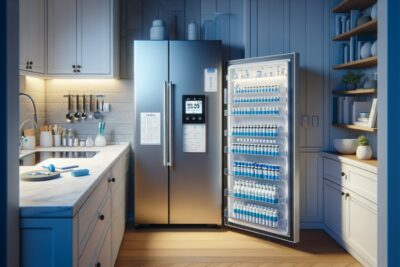
Keeping track of your blood sugar levels is a key part of managing diabetes. Whether you're living with type 1 or type 2 diabetes, knowing your glucose levels will help you manage your condition effectively. With proper monitoring, you can make informed decisions about diet, exercise, and medication.
By understanding how to conduct these checks and what your results mean, you can take proactive steps towards maintaining your health and preventing potential complications associated with diabetes.
🔍 Seeking a breakthrough in Type 2 Diabetes management?
Discover our expert insights and innovative approaches on ‘How to Cure Diabetes’.
Click to transform your health journey today!
What you\'ll find in this article?
Why test blood sugar levels?
Monitoring your blood sugar is essential for managing diabetes and preventing complications. Regular testing can help you understand how different foods, medications, and activities affect your glucose levels.
Testing also allows for medication adjustments before blood sugar levels become too high or low. Those who manage their diabetes with insulin or certain oral medications are at higher risk of hypoglycemia, making testing even more important.
By keeping a close eye on blood sugar fluctuations, you can work alongside healthcare professionals to tailor your diabetes management plan for better control and improved health outcomes.
Explore our specialized services in diabetes care 🌟.
From personalized diet plans to effective exercise routines, we have what you need to take control of Type 2 Diabetes.
Visit our services page now!












How to check your blood sugar levels
Checking your blood sugar levels involves using a blood glucose monitor or a continuous glucose monitoring system (CGM). Both methods require a small sample of blood, usually from your fingertip.
With a glucose monitor, you'll use a lancet to draw a drop of blood to place on a test strip inserted into the meter. The meter will then give you a glucose reading.
CGMs, on the other hand, measure glucose in the interstitial fluid beneath the skin. A sensor is inserted under the skin and sends readings to a receiver or smartphone app, providing real-time data and trends.
What are the target ranges?
Target blood sugar levels vary depending on individual health conditions and factors like age. Generally, for most adults with diabetes, before-meal glucose levels should be between 80 to 130 mg/dL (millimoles per liter).
Two hours after eating, levels should be less than 180 mg/dL. However, these ranges can differ, and it's important to speak with healthcare professionals to determine your personalized target range.
Regularly staying within your target range can help prevent or delay diabetes complications, including nerve, kidney, and heart diseases.
What affects your results?
Your blood sugar levels can be influenced by various factors such as your diet, physical activity, medications, and stress levels. Consuming high-carbohydrate foods can cause a spike in blood sugar levels.
Exercise, on the other hand, typically lowers blood glucose levels. It's important to monitor your levels more closely when you change your physical activity routine.
Other factors like illness, alcohol consumption, and hormonal changes can also affect blood sugar levels. Understanding these influences can help you manage your diabetes more effectively.
How often should you test your blood sugar?
The frequency of blood sugar testing should be based on the type of diabetes you have, your treatment plan, and how well your blood sugar levels are controlled. For those with type 1 diabetes, testing multiple times a day may be necessary.
For those with type 2 diabetes, the testing frequency might be less but is still important, especially for those on insulin or who have difficulty controlling blood glucose levels. Monitoring before meals and at bedtime is often recommended.
For those managing diabetes with diet and exercise alone, checking blood sugar less frequently may be appropriate. Your healthcare provider will help you decide the right schedule for your needs.
When to call your doctor about your blood sugar?
If your blood sugar levels are persistently above or below your target range, it's critical to contact your doctor. They may need to adjust your treatment plan.
High blood sugar levels over time can lead to long-term complications, while low blood sugar levels can cause immediate danger. If you experience symptoms of severe high (hyperglycemia) or low blood sugar (hypoglycemia), seek medical attention immediately.
It is particularly important to reach out to your healthcare team if you experience any sudden changes in blood sugar levels without an obvious cause.
What is the normal range for blood sugar?
The normal range for blood sugar levels can vary, but a common target for fasting blood glucose is between 70 and 99 mg/dL and less than 140 mg/dL two hours after eating.
These values can vary based on individual health conditions, so it's essential to discuss your specific targets with your healthcare provider.
What should your blood sugar be when you check it?
When checking your blood sugar, aim for a level within your target range, usually 80 to 130 mg/dL before meals and less than 180 mg/dL after meals for most adults with diabetes.
Personalized advice from healthcare professionals is crucial as individual needs may vary.
How do you properly check blood sugar?
To properly check blood sugar, wash your hands, prepare the lancet and meter, prick your fingertip, and apply the blood to the test strip. Follow the instructions specific to your device for accurate results.
Maintaining your glucose monitor and regularly calibrating it if needed is also important for reliable readings.
What should your blood sugar be 2 hours after eating?
Two hours after eating, called the postprandial period, your blood sugar levels should typically be less than 180 mg/dL. Staying under this level helps prevent long-term complications of diabetes.
Monitoring post-meal glucose can provide insight into how your body responds to specific foods.
Can I check my blood sugar without a blood test?
Traditional methods of checking blood sugar levels require a blood sample. However, new technologies like continuous glucose monitoring (CGM) systems can measure glucose levels without finger-prick tests.
CGMs use a small sensor placed under the skin to send glucose readings to a receiver or smartphone.
When is the most accurate time to test blood sugar?
The most accurate time to test blood sugar can depend on your goals for the reading. Fasting glucose levels are best checked in the morning before eating or drinking anything other than water.
For postprandial glucose levels, testing two hours after the start of a meal is generally recommended to gauge how the meal affected your glucose levels.
Monitoring blood sugar levels regularly is a critical component of diabetes management. With proper techniques and understanding of your target ranges, you can maintain better control over your condition and reduce the risk of complications.
For a visual guide on how to monitor your blood sugar levels, consider watching this informative video from our curated selection.
Remember, while self-monitoring is vital, it should always be complemented with regular check-ups with your healthcare team. By staying informed and vigilant, you can lead a healthier life, even with diabetes.
✨ Other articles you might be interested in:



